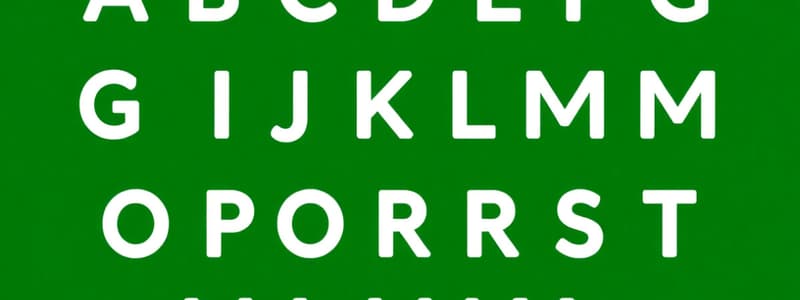Podcast
Questions and Answers
Match the following alphabet-related concepts with their descriptions:
Match the following alphabet-related concepts with their descriptions:
Phonics = The relationship between letters and their sounds Orthography = The study of spelling systems Phonetics = The study of speech sounds Grammar = The rules for constructing sentences
Match the terms with their usage in English:
Match the terms with their usage in English:
Capital letters = Used at the start of sentences and for proper nouns Lowercase letters = Used for most of the text Alphabet = Fundamental for written communication Letter order = Standardized arrangement A to Z
Match the following language components with what they represent:
Match the following language components with what they represent:
Letters = Represent sounds in a language Words = Formed by letters Sentences = Composed of words Vocabulary = The collection of words in a language
Match the following language aspects with their descriptions:
Match the following language aspects with their descriptions:
Match the concepts related to letters with their description:
Match the concepts related to letters with their description:
Match the language fundamentals with their application:
Match the language fundamentals with their application:
Match the related concepts to their functions:
Match the related concepts to their functions:
Match these variations of the alphabet with their descriptions:
Match these variations of the alphabet with their descriptions:
Flashcards
What is the English alphabet?
What is the English alphabet?
The English alphabet consists of 26 letters used to represent sounds in English. They are arranged in a specific order and used to form words, phrases, and sentences.
What is the order of letters in the alphabet?
What is the order of letters in the alphabet?
A standard order of the letters from 'A' to 'Z' used for alphabetizing resources like dictionaries and encyclopedias.
What are uppercase and lowercase letters?
What are uppercase and lowercase letters?
An uppercase letter is a larger, more prominent form of a letter, used at the start of sentences and for proper nouns. A lowercase letter is the smaller version.
How are sounds represented by letters?
How are sounds represented by letters?
Signup and view all the flashcards
Why is the alphabet important?
Why is the alphabet important?
Signup and view all the flashcards
Are there variations in alphabets?
Are there variations in alphabets?
Signup and view all the flashcards
What are phonics and phonetics?
What are phonics and phonetics?
Signup and view all the flashcards
What are orthography, grammar, and vocabulary?
What are orthography, grammar, and vocabulary?
Signup and view all the flashcards
Study Notes
The Alphabet
- The English alphabet has 26 letters.
- Letters are arranged in a specific order.
- Each letter corresponds to a sound in the English language.
- Letters form words, phrases, and sentences.
- Letters are used in various communication methods including writing, printing, and typing.
- Uppercase and lowercase forms of letters exist.
- Capital letters start sentences and are used for proper nouns (e.g., names, places).
Letter Order
- The alphabet's order is standardized.
- It begins with 'A' and continues to 'Z'.
- This order is used for alphabetization in dictionaries, encyclopedias, and other reference materials.
- Nonstandard or alternative alphabets may have a slightly different order.
Uppercase and Lowercase Letters
- Each letter has a capital (uppercase) and a lowercase (small) version.
- Capital letters begin sentences and emphasize key words.
- Lowercase letters are used for the rest of the text.
- Lowercase letters are generally easier and more compact to write or print.
Letter Sounds
- Each letter represents one or more English sounds.
- Letters like 'c' can have multiple sounds depending on the word.
- The sound of a letter can vary between words.
- Phonetic transcriptions sometimes represent letter sounds.
Importance in Language
- The English alphabet is essential for written communication.
- It provides a standard way to represent spoken language in text.
- Without an alphabet, there would be no organized written communication.
- The alphabet creates words with specific meanings.
- It's a key part of almost any literacy system.
Variations
- The 26-letter English alphabet is widely used.
- Many other languages utilize their own alphabets.
- Some languages, like Japanese, use different scripts.
- Other languages might modify the Latin alphabet.
Related Concepts
- Phonics: Links letters to their sounds.
- Phonetics: Studies speech sounds.
- Orthography: Studies spelling systems.
- Grammar: Rules for forming sentences.
- Vocabulary: The collection of words in a language.
Studying That Suits You
Use AI to generate personalized quizzes and flashcards to suit your learning preferences.



